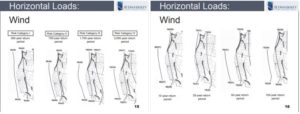When considering drift limits, how conservative are you when selecting your Mean Recurrence Interval wind load? Do you typically use the nominal wind speeds from the maps provided in ASCE 7 and consider those to be conservative for serviceability? Engineers can use their judgment to best decide which MRI is appropriate for any given project, and in many cases, a less restrictive MRI might be best suited for drift evaluation.
In the May 2021 SE University session, Emily Guglielmo, SE, from Martin/Martin, presented Serviceability for the Practicing Engineer. Emily explained the current serviceability requirements that are codified and addressed key serviceability concerns for various building materials. Emily discussed practical limits for both vertical and horizontal deflections and the need for engineering judgment in serviceability considerations.
For horizontal loads, Emily specifically addressed drift due to wind since seismic deflections are typically controlled by life safety considerations. Wind, however, is a daily phenomenon for which a building should be properly designed to handle appropriate deflections without resulting damage to the structure or its finishes. Emily noted that in the Commentary to Appendix C in ASCE 7, the mean recurrence interval (MRI) is addressed for use in determining deflections for serviceability, as shown on the slide below.
Equation CC-3 introduces a term, Wa, which does not appear in the standard, but is rather specific to the commentary. This Wa term is a wind load based on serviceability wind speeds from Figures CC1-CC4 which include wind speeds for MRIs of 10, 25, 50, and 100-year returns. Emily included comparisons between the wind speed maps from the standard to compare to the maps in the commentary.
As shown in the slides, the maps included in the commentary show significantly lower wind speeds and the commentary explicitly states that the “selection of the MRI for serviceability evaluation is a matter of engineering judgment…” Thus, engineers may use a less conservative MRI for serviceability considerations depending on the needs of the client, the materials in use, and the occupancy of the building, and the commentary implies that this is entirely reasonable. Of course, the designer may still opt to use the full nominal wind speed specified in Chapter 26 of the standard as the most conservative option for drift determination.
For some drift sensitive buildings or buildings with brittle finishes, a more conservative MRI would be sensible, however, the availability of the additional maps in the commentary are especially useful for the engineer who wishes to exercise more precise judgment from project to project.


